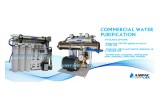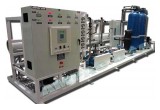AMPAC USA Shares Tips on Seawater Desalination Preventive Maintenance

Montclair, CA, April 15, 2017 (Newswire.com) - AMPAC USA, one of the leading manufacturers of reverse osmosis (RO) systems in the United States, designs RO systems that are intended, among other uses, for seawater desalination. As with any piece of equipment, RO systems will also benefit from preventative maintenance to continue running at optimum levels. AMPAC has released tips on how to keep your RO system running properly and for longer.
Maintaining a reverse osmosis (RO) water system requires minimal effort and can be done after 500 hours of usage. Along with regular maintenance, it is important for owners of water makers to conduct preventative maintenance of their RO systems. AMPAC has shared some tips to help users routinely conduct preventative maintenance.
Everybody says Save Water, We say just retreat the water.
Sammy Farag, CEO of Ampac USA
Regular Flush
To help the system run on full capacity, and to extend the life of the RO membrane, it will help to clean and flush the system completely at regular intervals. To make this process as simple as possible for operators, AMPAC has created the ‘Manual Flush’ switch located on the control panel. Pressing the switch will start the flushing process, which can be continued for 5 minutes after which it should be turned off.
If you don’t flush your RO system, and it lies unused for long periods of time, the membranes can dry out and will lead to a reduced lifespan. Keep the membranes running smoothly by making sure you flush the desalinator with fresh water.
Regular Cleaning
In addition to the flushing process, it is advisable to clean the water maker with a damp cloth. This will help locate any source of leakages, both water, and oil, from the pump. Vibrations are one of the main causes of leakages in an RO and the high-pressure pump is most susceptible to leakages. Also check for screws, nuts and bolts that may have become loose from the vibrations.
Conduct Daily Checks
To ensure the smooth running of a reverse osmosis water system, checking a few vital signs will bring up any problems immediately, and won’t allow them to build up into bigger issues at a later stage. On a daily basis, AMPAC suggests checking the feed water pressure, the booster pump pressure and checking the product and drain flow rates. It is also advisable to check the system pressure to keep track of any unusual behavior.
By checking to see if the pressure is falling below a certain point, operators will be able to replace any faulty filters immediately. Not taking this preventative step will mean waiting till the RO’s abnormally low pressure triggers the cut-off point and the system stops working completely. Daily pressure checks also add to the system’s lifespan.
Weekly & Monthly Checks
As a preventative measure, in addition to daily checks, other checks can be made on a weekly or monthly basis. This includes checking and recording vital statistics such as:
- flow rates of the product and the drain
- feed water temperature
- TDS of the product water
- Checking to see if fittings are connected properly and have not become loose due to vibrations created.
Replacing Pre-Filters
Prolonged use naturally leads to filters being replaced and AMPAC highly suggests using only the recommended pre-filters as any other types may not be compatible with the system and will not be able to last under high pressure and regular usage.
When working in areas with high salt content, it is recommended that along with the standard 20-micron pre-filter, operators should also install a pre-filtration system using a 5-micron pre-filter. This will ensure that the RO is receiving sufficient water flow at all times.
Log Book and Testing
Keep a system performance record which will be a useful troubleshooting manual to easily look up problems in the future. Once you have taken steps to ensure preventative maintenance, it is recommended to test the RO water makes to ensure everything is running as it should.
AMPAC suggests following these preventative maintenance steps to keep your RO water system running as smoothly as possible and to extend the system’s lifespan.
Download the Manual to get more information regarding maintenance or Contact us.
Source: AMPAC USA




